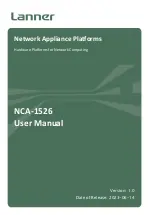
PES-100 Phoneline Ethernet Switch
4 Switch Operations
4.1
Store and Forward
The switch employs a store-and-forward architecture. The switch stores a
complete packet in an internal buffer and does the complete processing, including
error checking, before transmitting it to the network. Packets with error are
discarded, so they will not disturb the network.
4.2
MAC Address Table and Learning
The switch has a MAC (Medium Access Control) address table. The switch
remembers where a station is by storing its address information, including MAC
address, port ID, etc, in an entry of the table. This table is the base for packet
forwarding and filtering.
When a packet comes in from a port, the switch stores the source address, port ID
and other related information if the source address is not already in the table.
4.3
Forwarding and Filtering
4.4 Virtual
LAN
The Virtual LAN (VLAN) feature of the phoneline networking switch is an important
security mechanism. Without VLAN, the stations on the whole network can
access one another’s shared resources, e.g., shared hard disks and printers. To
eliminate this security risk, you partition the network into different groups with
VLAN, which prevents stations in different groups from communicating with each
other directly. VLAN also limits the broadcast packets to within the groups that a
port belongs, resulting in lessening the overall traffic on the network.
For the individual subscribers, you should put each one in a separate group by
assigning one unique VLAN ID to each phoneline networking port. For the
Ethernet ports, since all phoneline networking traffic goes through them, you
should put them in all the groups, i.e., they have VLAN IDs of all the phoneline
networking ports.
After processing the source address, the switch looks up the destination address
in the MAC address table to find the port on which to forward the packet. If an
entry is found and the outgoing port is different from the incoming port, the packet
is forwarded on the outgoing port; if the outgoing port is the same as the incoming
port, the packet is discarded, or filtered. If the destination is not found in the table,
the packet is forwarded to all other ports except the one from which the packet
comes in.
8












































